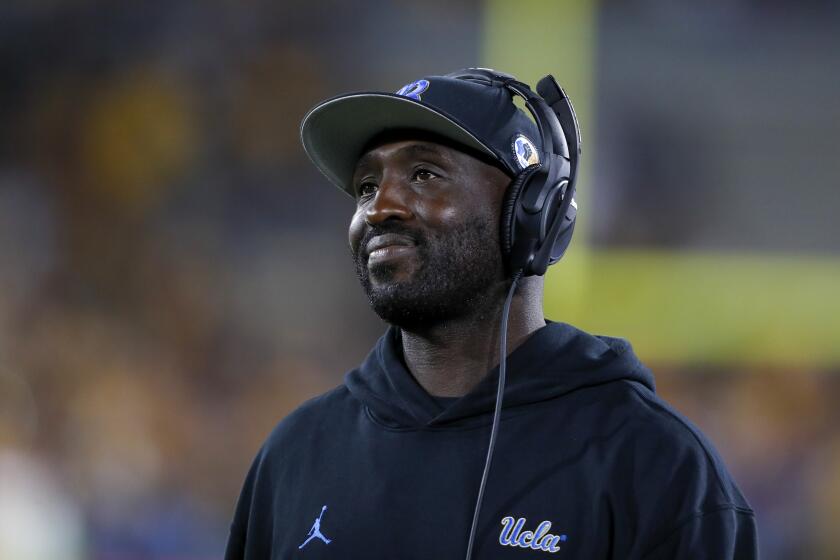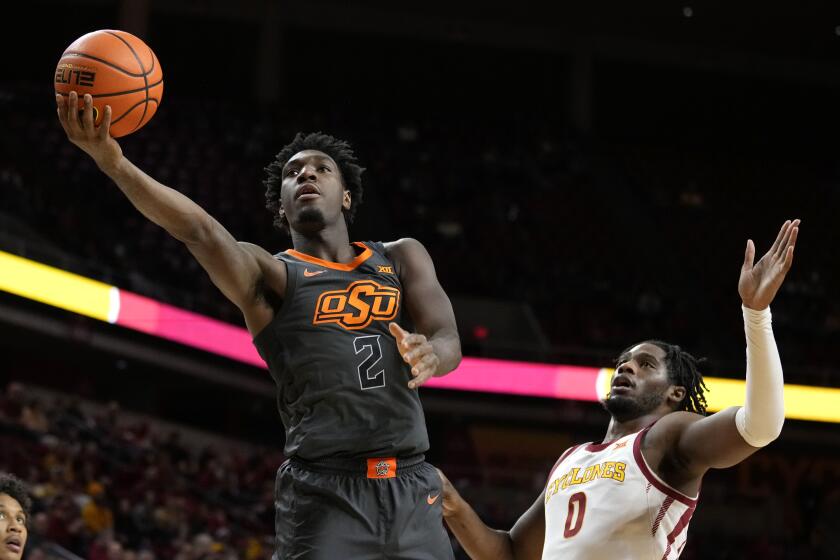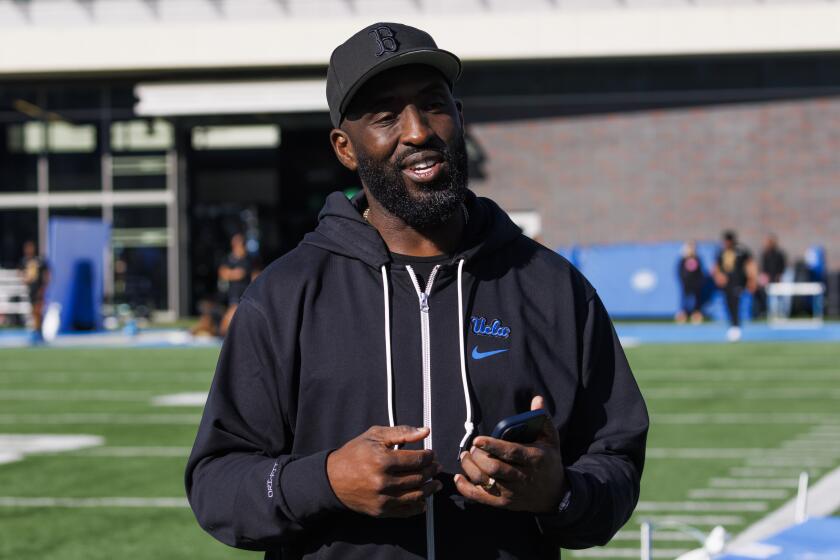A new appreciation for fine art of bracketing
I was UCLA Athletic Director Dan Guerrero for a day last week, except I didn’t wake up mumbling, “UCLA 13, USC 9.”
Guerrero is on the 10-member committee that selects, seeds and brackets the NCAA men’s tournament field.
Last week, after the committee met in Indianapolis to prepare for its five-day marathon leading to the selection show March 11, the NCAA for the first time guided a group of outsiders -- 20 members of the U.S. Basketball Writers Assn. posing as committee members -- through the once-cloaked process as we selected our own field of 65.
If you’d been waiting to watch the CBS selection show, well, it would have been a long wait. We worked until almost 2 a.m. and blew our artificial deadline by nearly an hour and a half -- meaning Billy Packer would have had to fill a lot of dead air and “60 Minutes” would already have been on in the East.
By this week, our bracket was being ripped on talk radio in North Carolina for giving Duke a seeding as high as No. 4 in its region, and we were called morons for including conference tournament “winners” Evansville and High Point -- both chosen by the NCAA to illustrate the kind of havoc upsets wield on the process.
“We’ve been called worse,” said NCAA selection committee chairman Gary Walters, the Princeton athletic director who played on the 1965 Final Four team with Bill Bradley.
The idea of letting reporters in on the long-guarded secrets -- even the Rating Percentage Index only recently became public -- was to “demystify” the process, said David Worlock, associate director of the Division I men’s basketball championship.
Greg Shaheen, senior vice president of basketball and business strategies, and one of the moving forces behind what I can only consider a period of glasnost at the NCAA, said it was to provide “transparency.”
Or, as Walters put it, by letting us into the “chamber” after traveling to Indianapolis at our expense, the NCAA hoped to create a little empathy for the difficulty of the process.
Hey, we’re proud of one thing: We didn’t put Brigham Young in a Friday-Sunday bracket, as the committee did in 2003, only to be bailed out when BYU -- which doesn’t play on Sunday for religious reasons -- lost early.
UCLA, which in reality was battling to beat USC that night, ended up with the No. 1 seeding overall with a first-round game against Central Connecticut in Sacramento and a path to the West Regional in San Jose, where the Bruins potentially could have met Duke in a regional semifinal.
Guerrero -- aka me -- didn’t say a word or cast a vote on the subject, because whenever a vote involving UCLA arose, the computer screen I shared with Guerrero’s other half -- Wendell Barnhouse of the Fort Worth Star-Telegram -- blocked the box next to UCLA’s name, making it impossible for us to vote.
USC was ushered into the field on the first ballot and was seeded No. 4 in the East, opening against Pennsylvania in Spokane, Wash., with Indiana potentially next and a possible regional semifinal against North Carolina in East Rutherford, N.J.
Long Beach State and Cal State Fullerton -- neither of which has a chance without winning an automatic bid -- were left out after Pacific won the Big West tournament in an upset.
Almost all of that is conjecture that will change, except that UCLA probably will be headed for Sacramento and San Jose if it can hold on to one of the four No. 1 seedings.
As for that, after UCLA’s loss to West Virginia without point guard Darren Collison -- the Bruins remain No. 1 in the NCAA RPI -- Walters said Tuesday the committee would consider an injury and a team’s body of work in such a situation.
“I think I know what you’re referring to, and those type of issues are discussed,” Walters said. “I think that happens during the course of the year to just about everybody.”
Some of the things that struck me most about the process were how quickly the actual bracketing must be done -- last year’s committee did it in 56 minutes as the selection show approached -- as well as the lack of reliance on RPI, the complete obliviousness during the process to the sort of “story line” matchups being created, and the sophistication of the computer programs.
Most of the 34 at-large teams -- or at least the locks -- are chosen early in the process, but the actual placing of most of the teams in the bracket must wait until the final automatic bids are determined by the five conference title games Sunday.
Our last team in, Alabama, made it as an at-large only after Iowa failed to steal an automatic berth by upsetting Indiana in the imaginary Big Ten title game.
As for the RPI, it was seldom mentioned by the NCAA officials, and I was the one who said, “I don’t like Alabama a lot either right now, but if we leave a team with a No. 29 RPI and only five losses out of the bracket, we’d better be prepared to defend it.”
As for story lines -- and I’ve long subscribed to the theory that the committee has a sense of humor -- you are so focused on placing the teams in the regions as you look at a seeding chart rather than a bracket, you are oblivious to what you’ve created.
Zeroed in on such things as trying to avoid conference teams meeting before a regional final and following geographic principles, our group inadvertently served up a potential East Regional final between North Carolina Coach Roy Williams and Kansas, his former team, and a possible second-round game between Marquette Coach Tom Crean and his mentor, Michigan State Coach Tom Izzo.
And the computer programs -- I can’t fathom how the process was ever completed without them.
With a few mouse clicks, we could compare team sheets that noted such things as strength of schedule, record in the last 10 games, average RPI of teams defeated and lost to, and record against the top 50 in the RPI, the top 100, the top 200 and those below 200.
Once we began bracketing, the program instantly displayed the mileage to each regional site for the team we were considering, and after we selected the top-seeded team in a region, the same site was automatically filled in for the other teams in its four-team “pod” -- No. 8, No. 9 and No. 16 lines in the bracket.
As we grew fatigued, the battle was to avoid uttering the word “whatever.” Because to the 65 who are in and the ones who are left out, it really, really matters.
Still, I came away with the impression that although guidelines prohibit committee members from voting their interests and they must leave the room when their team is discussed, there probably is subtle psychological pressure to please the people you are hunkered down with for five days.
As for pressure, consider that for a few moments last year Shaheen thought he had lost the bracket without saving it -- only 30 minutes before the selection show.
Fortunately for Shaheen, Anthony Dean, a director of the men’s basketball championship, had been duplicating the bracket on a separate computer.
“If Anthony didn’t have it backed up, I definitely wouldn’t have been meeting with you today,” Shaheen said.
“I’d probably be driving you to the airport in the morning.”
One more thing about Shaheen after watching him help us fill in the bracket on a huge screen, conforming to every arcane principle in the book.
I’m just guessing, but I figure he’s brilliant at Sudoku -- if he ever has time.
*
Go beyond the scoreboard
Get the latest on L.A.'s teams in the daily Sports Report newsletter.
You may occasionally receive promotional content from the Los Angeles Times.



